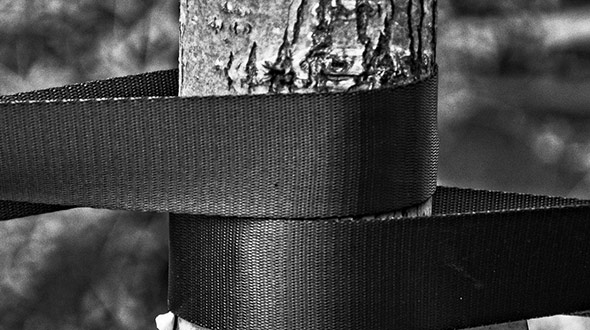
Your leaning tree can fall, causing catastrophic and life-threatening damages. By staking your tree, you can help it re-establish itself, prevent its death, and eliminate the danger of it falling.
toddsmariettatreeservices.com gathered information on why trees lean, how to properly stake them, and when tree removal may be necessary.
Why Trees Lean
Before taking action to stake or brace a tree, it’s helpful to understand the reasons why trees may lean in different stages of their growth.
The following require staking, bracing, or cabling and can be halted or reversed:
• The tree was planted off-center.
• The tree may be leaning towards the sun.
• The root ball has shifted in unsteady soil.
• Constant wind has shaped the tree to curve or has moved its center of gravity.
• The tree was struck by a vehicle or heavy machinery.
• Neighboring support trees were removed.
• The crown is off-center from poor pruning practices.
The following are irreversible and may require the immediate removal of the tree:
• An earthquake, floodwater, rockslide, or landslide has caused the root plate to destabilize and fail.
• Roots are failing due to rot from disease or poorly-drained soil.
• The tree trunk cracked.
As trees reach maturity, they can weigh from 2,000 to 20,000 pounds. When that weight becomes off-centered, and the tree begins to lean, quick action is required to prevent a fall with potentially deadly results.

Read How to Identify a Tree Emergency, and if you have a mature tree threatening to fall, call a tree professional to evaluate the immediate risk and lay out a course of action.
Tree Support Systems to Prevent or Stop Their Leaning
Support systems for young and leaning trees change as trees mature. The following are different systems used at various stages of tree development:
Planted as a Seedling – For the first 6 months to one year, the tree should be protected from the elements and wildlife by a chickenwire encircling enclosure, lined with burlap on the upwind side.
Transplanted Trees – Bare root and rootball transplants are highly susceptible to the elements until their root system extends and forms a firm root plate. These trees should be staked for 1 to 2 years while this process takes place.
Young trees planted as seedlings should be staked once they outgrow their protective enclosures to prevent leaning or severe weather damage.
To accomplish this:
1. Drive two 8 foot stakes 2 feet into the ground on either side of the tree trunk (about 1 1/2 feet from the trunk on each side).
2. Tie or attach a piece of burlap or other soft material – looped around the trunk – to each of the stakes. There should be enough slack for the tree to sway 3 to 6 inches in all directions before the material tightens around the trunk.
3. If wildlife is an issue, surround the tree with chicken wire using the stakes as a harness.
4. While a tree is staked, check the bark where any contact is made frequently. If damage or wear is detected, move the material up or down on the stakes.

Never tie or attach anything to trees being staked. Besides bark damage, the tree could end up girdled or sawed through if there is constant friction.
This staking method is highly effective until the trunk reaches a diameter at breast height (DBH) of 4.5 to 6 inches, at which point stronger measures are required.
Trees with a DBH >6 inches – When trees reach this size, they are heavy enough to cause severe to catastrophic damage if brought down during a storm or fall from their own weight. If they begin to lean, take the following actions immediately:

• Prune the tree to reset its balance or center of gravity.
• Cabling the tree can relieve pressure from branches, causing a redistribution of weight and stress within the crown.
• Anchor the tree to stop or reverse the lean by:
1. Driving a 5-foot heavy-duty iron stake into the ground 8 to 10 feet opposite the direction of the lean (this stake will be supporting tremendous weight).
2. Attach a cable rated for 1,400 to 1,960 pounds to the stake equipped with a turnbuckle or winching device, and loop the other end around the tree trunk above the first branches.
3. Use foam or rubber as a cushion to prevent the cable from directly contacting the tree’s bark.
4. Tighten the turnbuckle until the cable is firm. Then further tighten the cable every other day.
5. This process can last weeks and be successful provided there are no underlying issues with root rot or disease.
6. Call a professional to evaluate the state of the tree and offer guidance.
In all of the above situations, a tree professional should be called to evaluate the tree, determine why it is leaning, and what actions to take.
Staking Leaning Trees
Trees lean for different reasons, but there are various support systems to be used at different stages of the development of a tree.
In this article, you discovered why trees lean, how to stake or secure them properly, and when tree removal becomes necessary.
When your tree begins to lean, it is telling you something is wrong. Don’t procrastinate and allow a leaning tree to fall on your home or loved ones.
Sources:
gatrees.org/community-forests/ask-the-arborist/LeaningTrees-Whatsupwiththat.pdf
hort.ifas.ufl.edu/woody/cabling.shtml
Todd’s Marietta Tree Services
(678) 505-0266

I usually think of informative content as dull but necessary for learning. Interesting informational articles like this are rare. This material is informational without being boring and intimidating. Thanks for posting this again.tree cutting services TorontoI am very impressed with your writing abilities. I am bookmarking this content
ReplyDelete